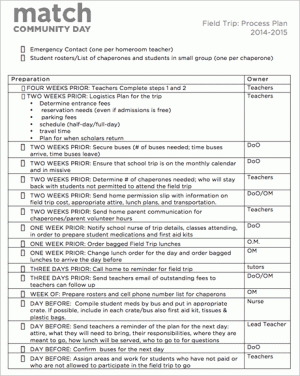Fret-Free Field Trips: Create a Timeline for Success
Successful school field trips require efficient planning, clear communication, and being prepared for anything. Here are some sample timelines for making it all work.
Now that your school year is up and running, you may already be thinking about out-of-classroom activities and adventures (otherwise known as field trips.) Whether you're making the annual kindergarten trip to the pumpkin patch, visiting a college campus with your sophomores, or taking your seventh grade class to an art museum, field trips are the perfect workout for your planning and organization muscles.
In addition to strong learning outcomes, an awesome field trip also means communicating with families, keeping kids safe, and making sure that everything (and everyone!) runs on time. The behind-the-scenes prep work is so important, as one missed step can result in a lost bus, confused chaperones, or a closed museum.
Timelines and Checklists
Here are three ways that teachers have created timelines to help organize the before, during, and after of field trips.
Claire Steinbeck, an early-childhood teacher in Washington, DC, planned to take her students to the National Building Museum. She made sure to outline every single step of planning, and she highlighted important communication points with families. She assigned clear owners to necessary tasks (for example, homeroom teachers were responsible for sharing field trip rules and expectations), and reviewed the list each week with her grade-level team. By planning, communicating, and even reviewing the timeline in advance, Claire set up her colleagues -- and the trip -- for success.
Julie Ann Clark, a middle school teacher in Austin, Texas, put together a checklist before taking her students bowling. My favorite thing about this checklist is how each step starts with strong, actionable verbs like "distribute," "create," and "assign." Julie Ann took no detail for granted. She ensured that the buses were scheduled, teachers' roles were clearly defined, and yes, drivers even received printed copies of the map and directions. Sure, she could assume that everyone had GPS, but better safe than sorry! Julie Ann kept her checklist active by reviewing it daily and digitally crossing off items as they were completed.
While many teachers plan each and every field trip on their own, some schools create a standard timeline to be implemented across a grade level or team. When expectations for deadlines are clear, templates are in place, and questions are answered in advance, the planning is much easier on teachers.

I love this model from MATCH Community Day in Boston.
This timeline shows exactly who is responsible for which steps of the process. Everyone knows his or her job, whether it's the nurse responsible for student medication or the Director of Operations (DoO) overseeing transportation. I also like how this model takes the guesswork out of knowing which materials and photocopies to have on hand. The more we can automate the basics, the more we can be flexible when (gulp) the bus gets a flat tire.
First Steps
Of course, once you've built your field trip timeline, you still need to share it, review it, and update it. Here are some pointers to help you get started:
- Create a timeline that works backward from the field trip date.
- Use strong action verbs for each step.
- Assign areas of ownership or tasks to other participants.
- Enter all dates into your comprehensive calendar so that none of the deadlines sneak up on you.
- Review and update your field trip timeline at least weekly.
And after that, have fun with your students on the trip!
